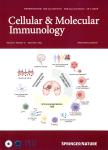Suppression of inflammatory gene expression in T cells by Porphyromonas gingivalis is mediated by targeting MAPK signaling
Suppression of inflammatory gene expression in T cells by Porphyromonas gingivalis is mediated by targeting MAPK signaling作者机构:Division of Clinical Medicine School of Health and Medical Sciences Orebro University Orebro Sweden
出 版 物:《Cellular & Molecular Immunology》 (中国免疫学杂志(英文版))
年 卷 期:2013年第10卷第5期
页 面:413-422页
核心收录:
学科分类:0710[理学-生物学] 07[理学] 071009[理学-细胞生物学] 09[农学] 071007[理学-遗传学] 0901[农学-作物学] 090102[农学-作物遗传育种]
基 金:supported by grants from the Swedish Research Council the Swedish Heart-Lung Foundation the Swedish Fund for Research without Animal Experiments the Swedish Heart and Lung Association the Foundation of Olle Engkvist the Foundation of Langmanska Kulturfonden
主 题:MAPK Porphyromonas gingivalis protei nases T cells
摘 要:There is increasing awareness of the effects of Porphyromonas gingivalis on host immune responses. Degradation of cytokines and chemokines by cysteine proteinases has previously been reported. However, the precise mechanisms by which P. gingivalis is able to alter intracellular signaling, and thus proliferation and inflammation, have not been descri bed. We have previously reported s u ppression of activator protei n-1 (AP-1) and degradation of I L-2 by protei nases from P. gingivalis. In the present study, we have analyzed the effects of P. gingivalis on Jurkat T-cell signal transduction and subsequent IL-2 and CXCL8 expression. We found that CXCL8, but not IL-2, gene expression levels were significantly suppressed by viable P. gingivalis. Analysis of intracellular signaling revealed an inhibitory effect of P. gingivalis on c-Jun and c-Fos, but not NFκB(p50and p65), NFATor STAT5expression. This inhibitory effect was not due to suppression of mitogen-activated protein kinase (MAPK) (p38, erkand JNK) gene expression, but was rather due to prevention of protein kinase C (PKC) and p38 phosphorylation, as demonstrated by western blot analysis. Furthermore, SOCS1 and SOCS3 expression levels decreased following treatment of Jurkat T cells with viable P. gingivalis. The results indicate that P. gingivalis is able to suppress inflammatory gene expression by targeting the activity of MAPK pathways in T cells, which was confirmed by using specific inhibitors of NF-κB, PKC, ERK, p38 and JNK.




